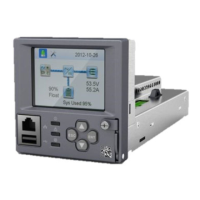Vertiv™ NetSure™ Control Unit (NCU) User Manual
• Equalize Stop Current: When in Equalize Charge mode and the battery charge current decreases below this setting for the
"Equalize Charge Stop Delay Time" time period, the system is transferred to Float Charge mode. For example, a value of
0.010C10 means that when the charging current is less than 1% of the battery's nominal capacity, the system returns to the
Float mode.
• Equalize Stop Delay Time: See "Equalize Stop Current" above.
NOTE!
If the power system has been automatically placed in Equalize mode, disabling Automatic Equalize will
not
return the
system to Float mode until the current Equalize cycle is completed. To return immediately to Float mode, select Float Charge
for the Equalize/Float Charge Control setting.
• Maximum Equalize Charge: This is the maximum duration, in minutes, that an automatic equalize charge will last regardless
of the other settings.
• Cyclic Equalize : Enables or disables cyclic (scheduled) equalize charging. When enabled, the following parameters can be
set.
Cyclic Equalize Interval: Cyclic (scheduled) equalize charging interval.
Cyclic Equalize Duration: Cyclic (scheduled) equalize charging duration.
• Cyclic Equalize Start Time: Sets the start time for equalizing (date/time you want the cyclic EQ to start). The date is
displayed based on the Date Format selected.
Example setting: mm/dd/yyyy hr.
• EIB-1 Voltage Type: The EIB assembly provides a total of eight (8) DC voltage inputs for battery block monitoring.
- 24 (Block 2): Selects the EIB to monitor up to four (4) 24V battery strings with two (2) 12V blocks per string.
- 48 (Block 4): Selects the EIB to monitor up to two (2) 48V battery strings with four (4) 12V blocks per string.
- Mid Point: Selects the EIB to monitor the midpoint voltage of up to eight (8) battery strings for either 24V or 48V
systems.
- Disabled: Disables the battery block monitoring feature.
• EIB-1 Block Voltage Diff: This menu item appears if “24 (Block 2)” or “48 (Block 4)” is selected above. The “EIB-1 Block
Voltage Diff” setting selects the alarm threshold for battery block monitoring. The NCU issues an alarm when any block
voltage of any battery string has an abnormal value. The alarm is issued when the difference between any block voltage and
a reference voltage is greater than the value of the block voltage difference setting.
• EIB-1 Block Voltage Diff (Mid): This menu item appears if “Mid Point” is selected above. The “EIB-1 Block Voltage Diff
(Mid)” setting selects the alarm threshold for battery midpoint monitoring. The NCU issues an alarm when any battery
midpoint voltage of any battery string has an abnormal value. The alarm is issued when the difference between any battery
midpoint voltage and a reference voltage is greater than the value of the block voltage difference setting.
• EIB-1 Block In-Use Num: Number of 12V battery blocks being used.
• EIB-2 Voltage Type: The EIB assembly provides a total of eight (8) DC voltage inputs for battery block monitoring.
- 24 (Block 2): Selects the EIB to monitor up to four (4) 24V battery strings with two (2) 12V blocks per string.
- 48 (Block 4): Selects the EIB to monitor up to two (2) 48V battery strings with four (4) 12V blocks per string.
- Mid Point: Selects the EIB to monitor the midpoint voltage of up to eight (8) battery strings for either 24V or 48V
systems.
- Disabled: Disables the battery block monitoring feature.
• EIB-2 Block Voltage Diff: This menu item appears if “24 (Block 2)” or “48 (Block 4)” is selected above. The “EIB-2 Block
Voltage Diff” setting selects the alarm threshold for battery block monitoring. The NCU issues an alarm when any block

